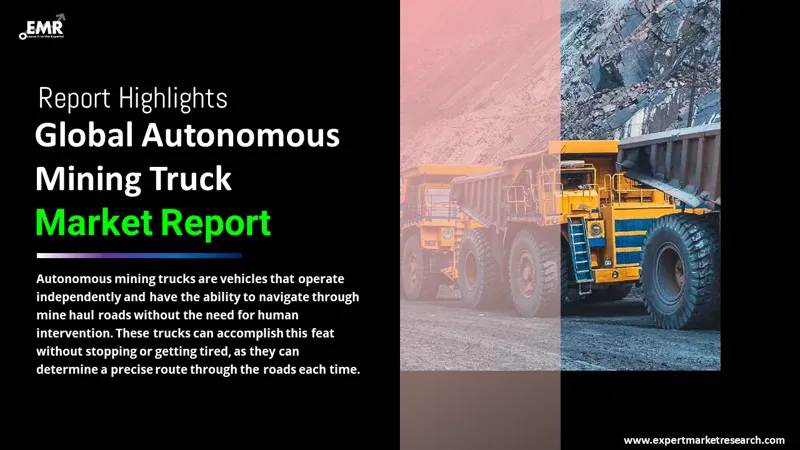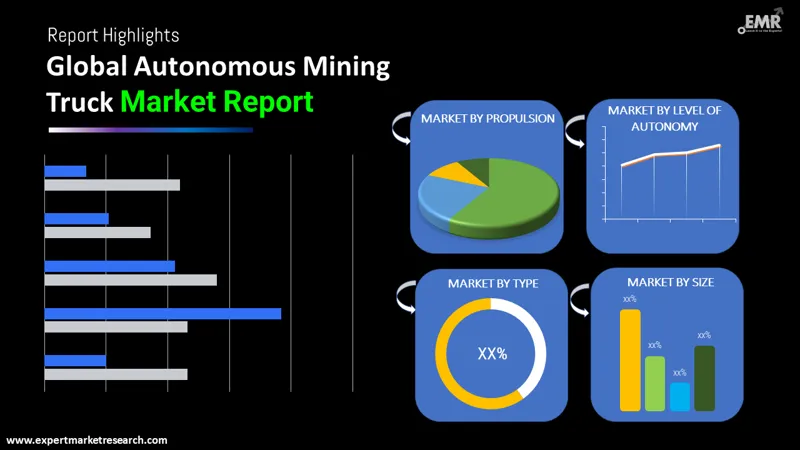
Consumer Insights
Uncover trends and behaviors shaping consumer choices today
Procurement Insights
Optimize your sourcing strategy with key market data
Industry Stats
Stay ahead with the latest trends and market analysis.
The global autonomous mining truck market size is expected to grow at a CAGR of 16.50% between 2026 and 2035, driven by the growth of the mining sector and advancements in technology for smart mining.
Base Year
Historical Period
Forecast Period
Compound Annual Growth Rate
16.5%
2026-2035
*this image is indicative*
Autonomous mining trucks are self-driving, autonomous vehicles that can determine a precise route through mine haul roads each time without stopping or tiring. Self-driving trucks require fewer workers on the job site and reduce the risk of human mistake from exhaustion. Autonomous mining trucks utilise technologies such as radar and LiDAR to detect objects around it, reducing the risk of accidents and collisions with other heavy vehicles on mine haul roads which are accelerating the autonomous mining truck market demand.

Read more about this report - REQUEST FREE SAMPLE COPY IN PDF
The EMR’s report titled “Autonomous Mining Truck Market Report and Forecast 2026-2035 offers a detailed analysis of the market based on the following segments:
Market Breakup by Type
Market Breakup by Size
Market Breakup by Propulsion
Market Breakup by Level of Autonomy
Market Breakup by Region

Read more about this report - REQUEST FREE SAMPLE COPY IN PDF
As per the autonomous mining truck market research, underground LHD (load haul dump) loaders account for a leading share of the market. Underground LHD loaders aid in loading, hauling, and dumping materials from open mining sites to other vehicles that take the materials to the surface. Due to the uneven terrain, limited space, and risk in driving, utilising autonomous underground LHD loaders offers significant advantages over manual movement alternatives. The low-noise, zero-emission underground LHD loader was created to meet the diverse requirements of narrow vein mining. To maximise running time, they are long-lasting, easy to maintain, and simple to use. The many advantages of underground LHD loaders which include its small size, simplicity of use, increased productivity, and minimal pollution emissions, are aiding the autonomous mining truck market growth.
Asia Pacific accounts for a significant share of the market for autonomous mining trucks due to the expansion of the mining industry and favourable policies for mining of various governments in the in the region. Rising mineral demand, lower-grade mineral discoveries in outlying locations, and a shortage of skilled labour are further supporting the rapid growth in the use of autonomous technology in haul trucks in the Asia Pacific. The need for naturally existing minerals is rising across a variety of industries, which is driving up mining activities for the extraction of solid minerals and increasing the emphasis on the use of cutting-edge mining equipment, expanding the autonomous mining truck market size in Asia Pacific.
The comprehensive EMR report provides an in-depth assessment of the market based on the Porter's five forces model, along with giving a SWOT analysis. The report gives a detailed analysis of the following key players in the global autonomous mining truck market, covering their competitive landscape and the latest developments like mergers, acquisitions, investments, and expansion plans.
Caterpillar Inc., with headquarters in Texas in the United States, is a world leading producer of diesel-electric locomotives, industrial gas turbines, construction and mining equipment, and diesel and natural gas engines. The company was established in 1925 and its current product offerings include motor graders, articulated trucks, dozers, wheel loaders, engines, generators, backhoe loaders, skid steel loaders, and excavators.
Komatsu Limited, which has its headquarters in Tokyo, Japan, and was established in 1921, is a multinational corporation that manufactures diesel engines, industrial equipment like press machines, lasers, and thermoelectric generators, as well as equipment for the forestry, construction, mining, and military industries. With the power of data and technology, the company’s global service and distributor network supports customer operations to help improve safety, productivity, and performance.
Autonomous Solutions, Inc, founded in 2000 with its headquarters in Utah in the United States, designs and produces autonomous vehicle systems, software, and components for a range of industrial, agricultural, automotive proving ground, and military clients. With a focus on multi-vehicle command and control, mission planning, obstacle detection and avoidance, sensor fusion, tele-operation, and point-and-click ease of use, the company has vast expertise automating vehicles of all sizes and forms.
*Please note that this is only a partial list; the complete list of key players is available in the full report. Additionally, the list of key players can be customized to better suit your needs.*
Other market players include Volkswagen Group, AB Volvo, Hitachi Construction Machinery Co., Ltd., Epiroc AB, and SANY Group, among others.




*While we strive to always give you current and accurate information, the numbers depicted on the website are indicative and may differ from the actual numbers in the main report. At Expert Market Research, we aim to bring you the latest insights and trends in the market. Using our analyses and forecasts, stakeholders can understand the market dynamics, navigate challenges, and capitalize on opportunities to make data-driven strategic decisions.*
Get in touch with us for a customized solution tailored to your unique requirements and save upto 35%!
The market is projected to grow at a CAGR of 16.50% between 2026 and 2035.
The major drivers of the market include the expanding mining industry and the increased demand for metals.
The development of new mining sites, increase in demand for smart mining, and rising usage of technologically advanced mining equipment are the key trends propelling the growth of the market.
The major regions in the market are North America, Europe, the Asia Pacific, Latin America, and the Middle East and Africa.
The primary types of autonomous mining trucks in the market are underground LHD loaders and autonomous hauling trucks, among others.
Autonomous mining trucks aid in increasing productivity and safety with AI systems that can optimise the effectiveness of routes, charging cycles, loading times, and other processes.
The various sizes of autonomous mining trucks in the market are small, medium, and large.
The propulsions in the market are diesel, and electric and hybrid.
The different levels of autonomy of autonomous mining trucks in the market are Level 1 and 2, Level 3, and Level 4 and 5.
The major players in the autonomous mining truck market are Caterpillar Inc., Volkswagen Group, AB Volvo, Komatsu Limited, Hitachi Construction Machinery Co., Ltd., Epiroc AB, SANY Group, and Autonomous Solutions, Inc, among others.
Explore our key highlights of the report and gain a concise overview of key findings, trends, and actionable insights that will empower your strategic decisions.
| REPORT FEATURES | DETAILS |
| Base Year | 2025 |
| Historical Period | 2019-2025 |
| Forecast Period | 2026-2035 |
| Scope of the Report |
Historical and Forecast Trends, Industry Drivers and Constraints, Historical and Forecast Market Analysis by Segment:
|
| Breakup by Type |
|
| Breakup by Size |
|
| Breakup by Propulsion |
|
| Breakup by Level of Autonomy |
|
| Breakup by Region |
|
| Market Dynamics |
|
| Competitive Landscape |
|
| Companies Covered |
|
Single User License
One User
USD 3,999
USD 3,599
tax inclusive*
Datasheet
One User
USD 2,499
USD 2,249
tax inclusive*
Five User License
Five User
USD 4,999
USD 4,249
tax inclusive*
Corporate License
Unlimited Users
USD 5,999
USD 5,099
tax inclusive*
*Please note that the prices mentioned below are starting prices for each bundle type. Kindly contact our team for further details.*
Flash Bundle
Small Business Bundle
Growth Bundle
Enterprise Bundle
*Please note that the prices mentioned below are starting prices for each bundle type. Kindly contact our team for further details.*
Flash Bundle
Number of Reports: 3
20%
tax inclusive*
Small Business Bundle
Number of Reports: 5
25%
tax inclusive*
Growth Bundle
Number of Reports: 8
30%
tax inclusive*
Enterprise Bundle
Number of Reports: 10
35%
tax inclusive*
How To Order

Select License Type
Choose the right license for your needs and access rights.

Click on ‘Buy Now’
Add the report to your cart with one click and proceed to register.

Select Mode of Payment
Choose a payment option for a secure checkout. You will be redirected accordingly.
Gain insights to stay ahead and seize opportunities.

Get insights & trends for a competitive edge.

Track prices with detailed trend reports.

Analyse trade data for supply chain insights.

Leverage cost reports for smart savings

Enhance supply chain with partnerships.

Connect For More Information
Our expert team of analysts will offer full support and resolve any queries regarding the report, before and after the purchase.
Our expert team of analysts will offer full support and resolve any queries regarding the report, before and after the purchase.
We employ meticulous research methods, blending advanced analytics and expert insights to deliver accurate, actionable industry intelligence, staying ahead of competitors.
Our skilled analysts offer unparalleled competitive advantage with detailed insights on current and emerging markets, ensuring your strategic edge.
We offer an in-depth yet simplified presentation of industry insights and analysis to meet your specific requirements effectively.
Share